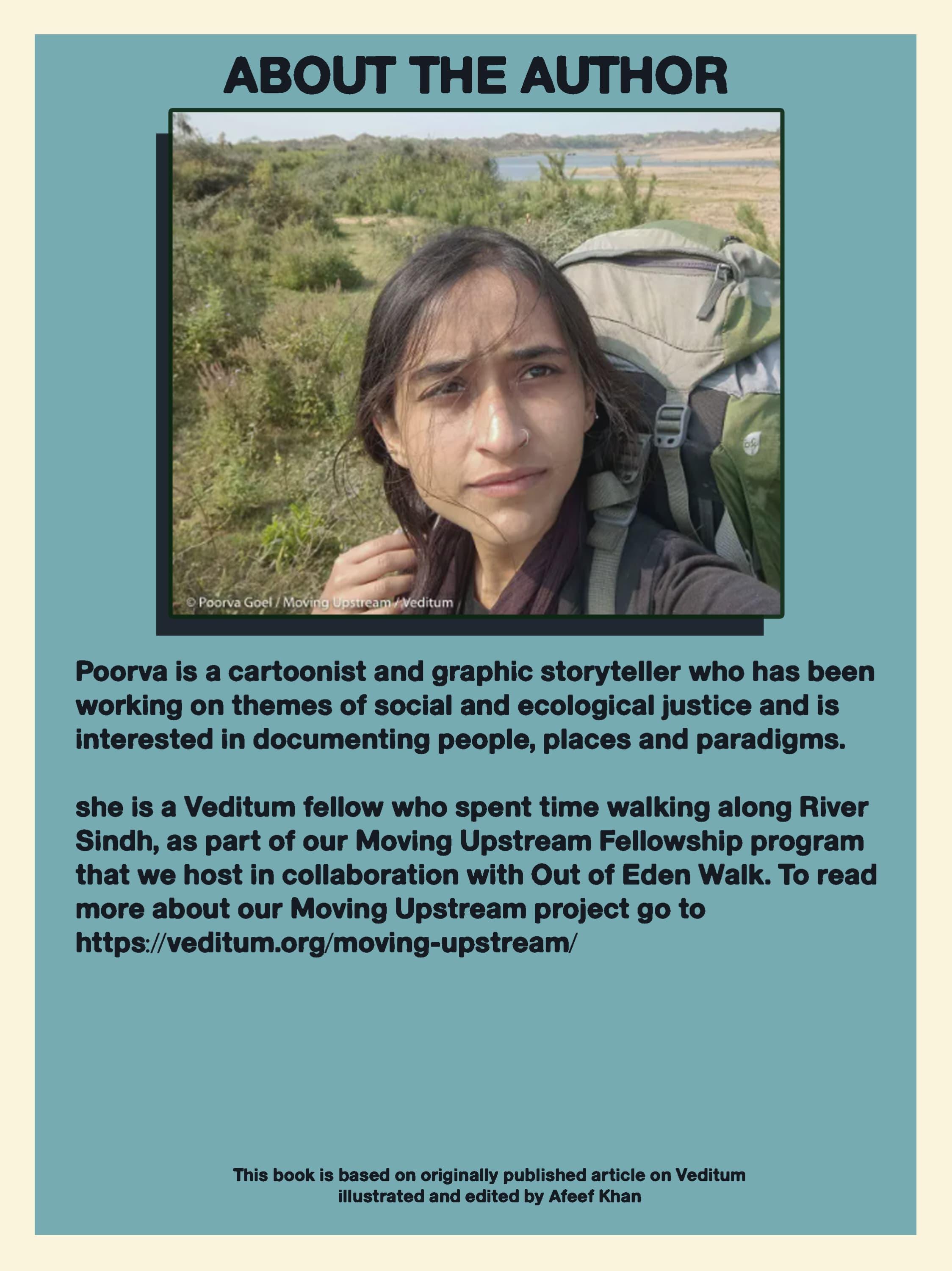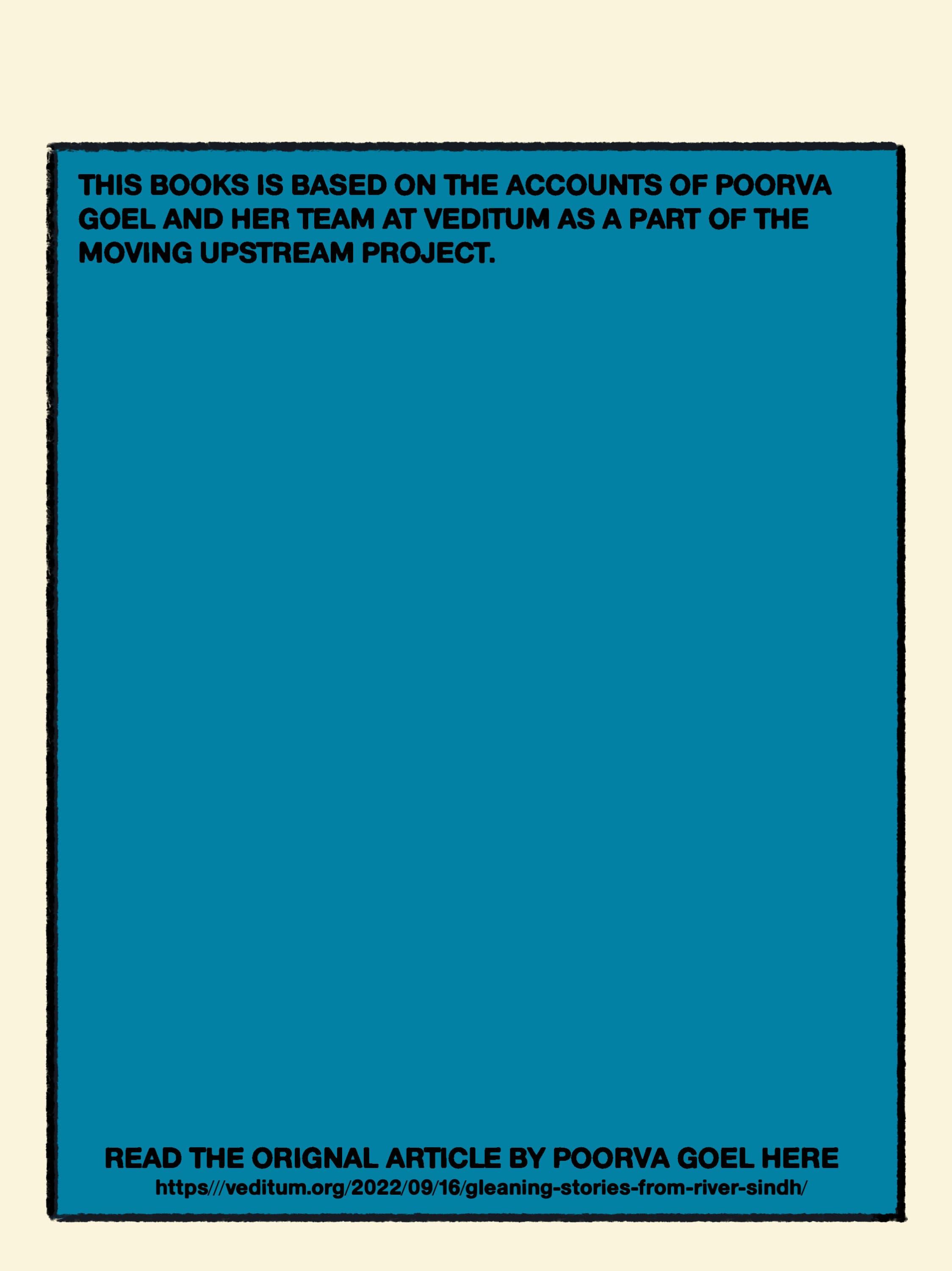
GLEANING STORIES FROM RIVER SINDH BASED ON THE WORKS OF POORVA GOEL ILLUSTRATED BY AFEEF
KHAN

1

2

3
D101 ZARA DAS RUIPAY TAPKADO NEECHE THEEK HAL

-w
YE
4
LOL

ARREY KO BAAT NAHI 5HUKRIYA DIO1, WO PEHLE KE UYE. TUM YAHA PE ROZ AATE HO? HAAN KYU HAM TO BAS BHENTH IKHATTA KARTE HAL, NADI K PAISE KI ZAROORAT| THOOI HAl 5
OYEL RAATU AAT KITNA BANA?

6
"Raju, a seven-year-old boy, collected coins that the pilgrimns left at the bridge. He did not want me to know that he doesn't go to school and instead gleans money and edible offerings by the river. "The financial situation at home and the condition of government schools have made him reluctant to attend school" admitted an older friend of Raju's, on his behalf"
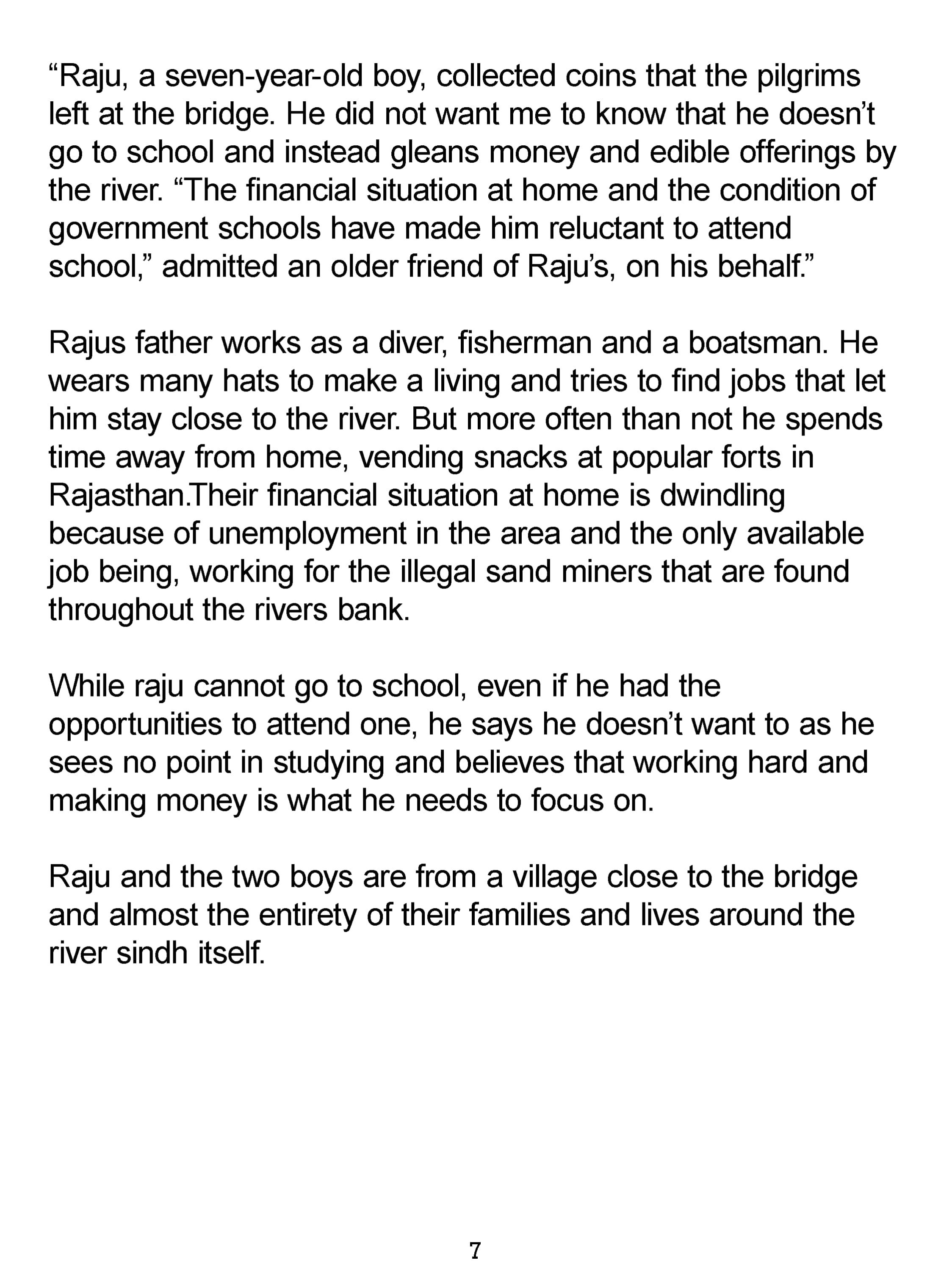
Rajus father works as a diver, fisherman and a boatsman. He wears many hats to make a living and tries to find jobs that let him stay close to the river. But more often than not he spends time away from home, vending snacks at popular forts in Rajasthan.Their financial situation at home is dwindling because of unemployment in the area and the only available job being, working for the illegal sand miners that are found throughout the rivers bank.
While raju cannot go to school, even if he had the opportunities to attend one, he says he doesn't want to as he sees no point in studying and believes that working hard and making money is what he needs to focus on.
Raju and the two boys are from a village close to the bridge and almost the entirety of their families and lives around the river sindh itself.
7
NAAM KYA HAI TUM SABKA?

YE KETAN, AI O 8
HAM RAJU HAI ALUR KEERTAN

YE KAAM KITNE TIME SEKAR RAHE HO TUM LOG? GAO KA HAMKO KUCH TEEN CHAR SAAL HO GAYA BAKI 0ONO NE ABHI SHURU KYA HAL JABSE PICHLE SAAL HALAT KI WAJAH\ SE HAM SAB BAADH AAYA HAL, MAUHAAL KAAFI KHARAAB HAI ALIR AB TO DAKU KA BHI OARR HAI YAHAPE AHA PAR ROZ AATE HAL. M L 9
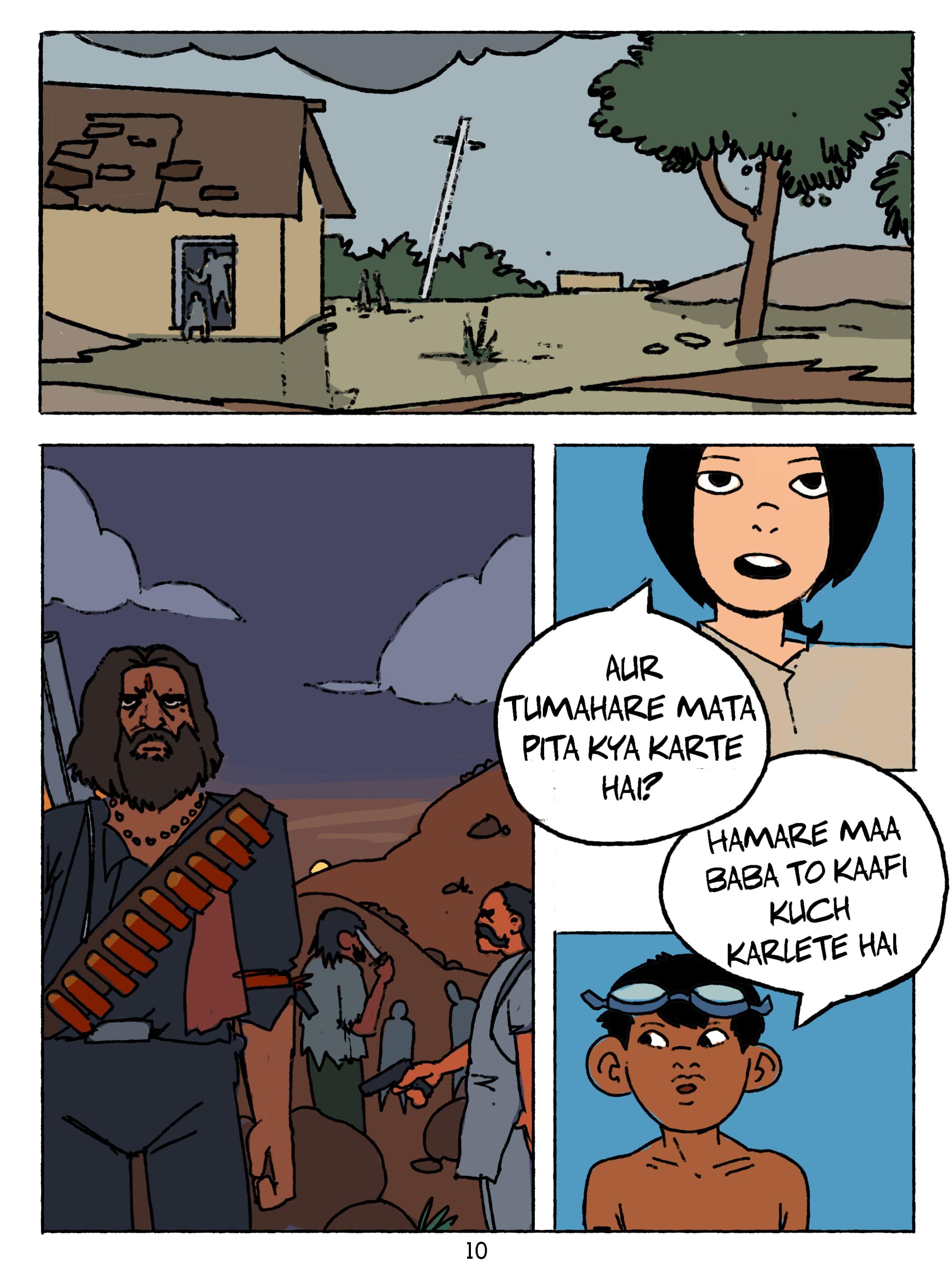
AUR TUMAHARE MATA PITA KYA KARTE HA HAMARE MAA BABA TO KAAFI KUCH KARLETE HAI 10
WO KYA HAI NA HAMARE MAA BABA SETH LOG KE UYE MITTI LAADNA NAHI CHAHTE

11
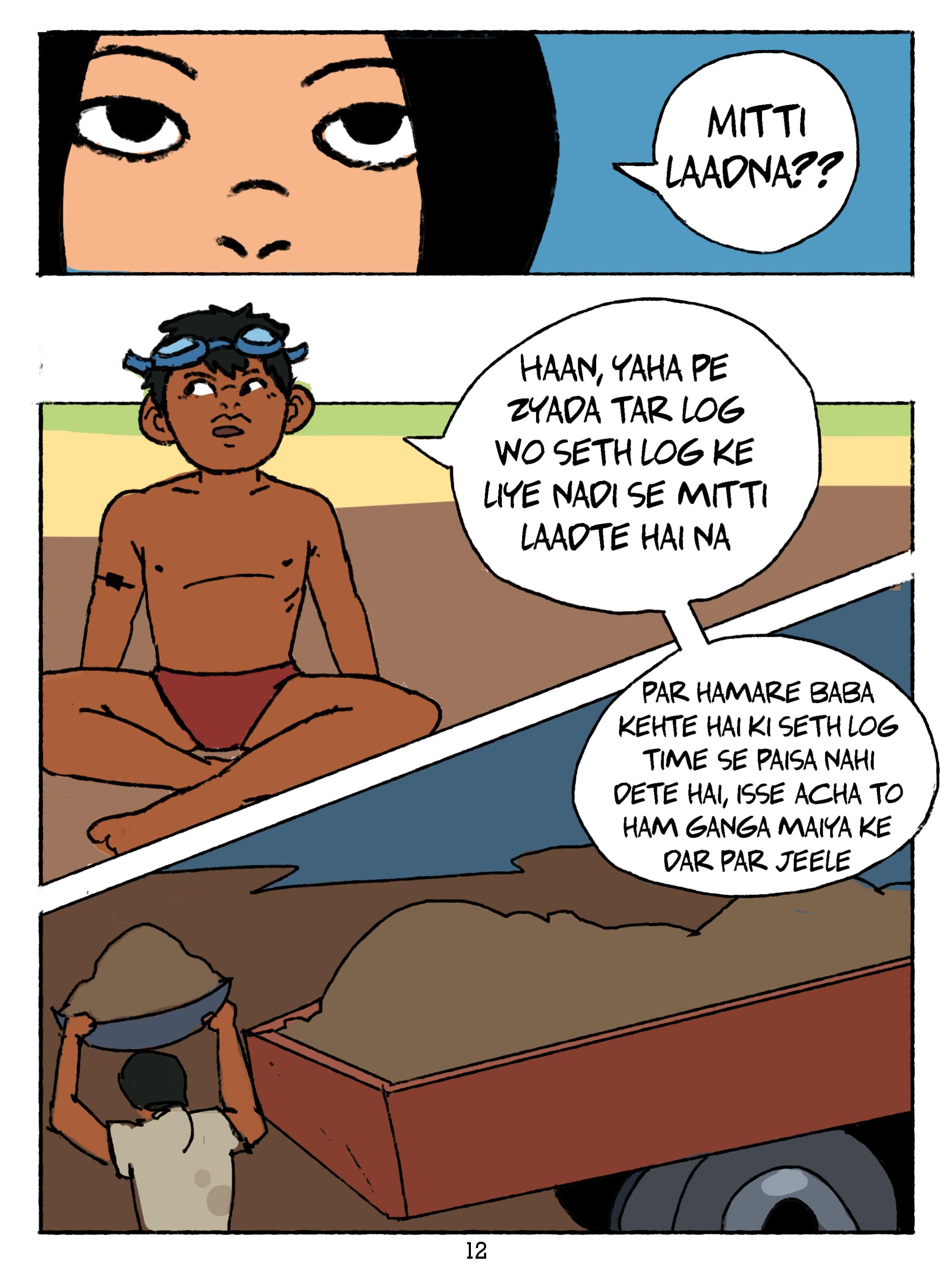
MITTI AADNA?? HAAN, YAHA PE ZYADA TAR LOG WO SETH LOG KE LYE NADI SE MITTI LAADTE HAI NA PAR HAMARE BABA KEHTE HAI KI SETH L0G TIME SE PAISA NAHI DETE HAL, 5SE ACHA TO HAM GANGA MAIYA KE OAR PAR JEELE 12
"On our foot traverse down from Seondha town, Madhya Pradesh, we had been warned to expect sand mining on the river. From a distance, we could see people working with shovels in the sand and immediately inferred that they were sand miners. As we cautiously inched closer, we saw that a family was tending to the saplings of gourds, cucumbers, pumpkin, chillies and coriander. This practice of riverbed farming was locally known as kachuari or kachuaee."
A local boatsman in Seondha- "I don't want to do it (sand mining). The tractor owners employ local people to mine the sand. They load tractors manually at night. It's done illegally. I don't do it because it involves a lot of violence. Sometimes they don't pay you on time and sometimes nothing at all. The tractor owner makes 10,000-20,000 rupees a night. We do all the work and he takes the money. You have to fight to get your share for your labour which is something Il am not able to do" text box with testimonial
"Workers and their machines would come to a standstill aas soon as they noticed us walking toward them from a distance. Their fixed, hostile gazes followed us till we were no longer in sight. Trucks pregnant with river sand frequently passed through the big small towns; one wonders how much of it is legal. Members of a local NGO in Bhind, explained the nexus of different stakeholders, and the extent and impacts of illegal sand mining on the Sindh. They considered unsustainable sand mining to be among the greatest threats to the Sindh river and its human and non-human ecosystems." "Some believed sand mining to be just another source of

13
livelihood for the locals. However, not only does it exploit the river but also those that are hired for lifting sand manually from ther river" While illegal sand mining is a threat to everyone that depens on the river its also only one of the problems the people of this region face, other problems like gang violence and fear of dacoits is prevelant too.
"Everyone around us was a little apprehensive about our journey ahead. Stories of a gang of 40 aatankis or dakus (dacoits) had begun resurfacing in the region we were traversing. Their origin was unclear- some had heard that it was men and women from families of rival gangs while others deduced that it had something to do with the preceding UP elections. Thanks to WhatsApp and social media, several rumours surrounding dacoits-on-the-run were sailing faster than the wind. We met at least one person in every village who knew someone who had heard that somebody had been recently shot and dragged by dacoits in broad daylight.Our conspicuous appearance in the bihad (ravines) set off alarm bells among some suspecting inhabitants. We were stopped and surrounded by villagers and eventually reported to the police for further investigation thrice within the first four days of Our walk."
In the regions surrounding the sindh river the people are on high alert to the point of taking arms and checking every stranger that passes by their villages. Kids like raju and his friends have been told to not stay out late and be aware of these aatankis and practice extreme caution.

14
Poorva's time with the boys were coming to an end, Poorva has spent a lot of time talking to boys like raju and she has got insights on how these boys support their families by collecting coins whenever they can due to the economical situations of these much neglected regions of India where many villages are not even on the map and many people have spent their entire lives in these areas seeing the conditions of life and the river's life only worsen over the years.

DI0 HAMSE MILNE WAPAS ZAROOR AANA! 15
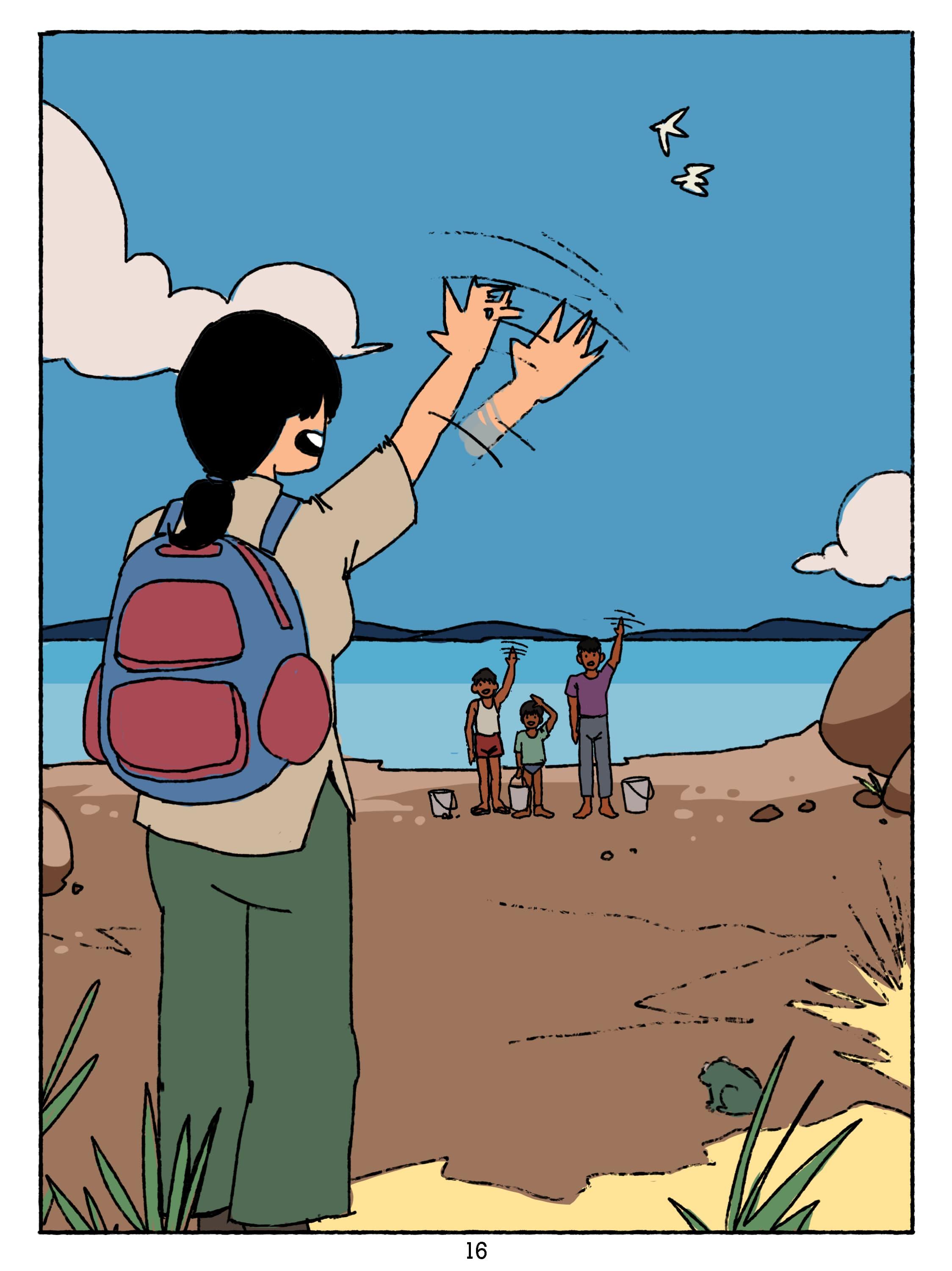
16
"During my last hour by the river, I waited in anticipation for a metaphor or an epiphany to strike that would encapsulate the meaning of a river but it didn't. I thought that perhaps the fragments of that meaning lay right in front of me. The meaning is made in relation to all that interacts with the river." "The Sindh is a conduit of life- culture, local economies, biodiversity and more. The Sindh, 470km long, forms an essential part of this intricate mesh of several tributaries, rivers and distributaries that have cradled and nurtured life across the northern span of India.
A better understanding of the river, its significance and why it must flow freely could keep this channel of life from disappearing out of existence. Revisiting my notes, sketches and photographs to write this piece I feel grateful to Veditum for this intimate experience with a river.
I am looking forward to digging deeper into and engaging with all that I absorbed in this walking study and sharing these humbling encounters with people, places and paradigms along the lesser-known Sindh rive"

17



















